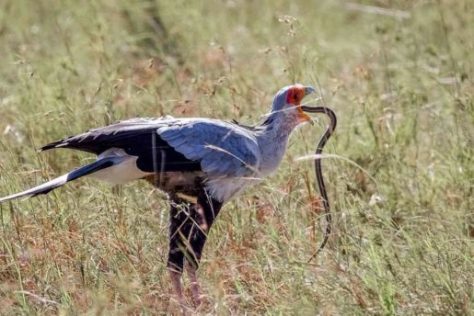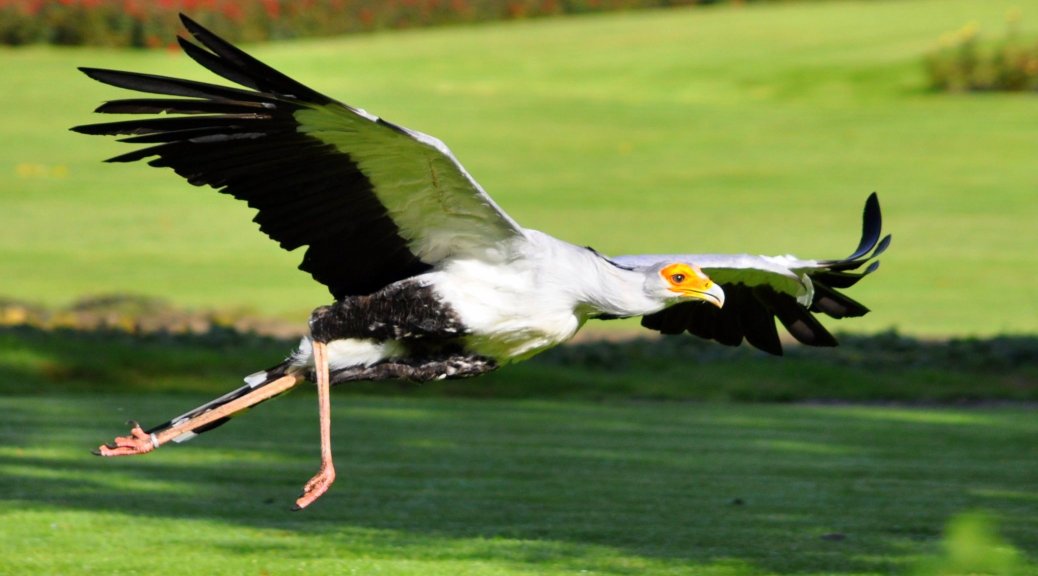Tall and stylish, at first sight the secretarybird reminds us of a stork or a crane: black and white plumage, long legs… but the beak and claws betray it. Beyond that they are all birds, they have little in common. Find out more about this especial bird of prey!
BIRDS OF PREY
Curved and powerful beaks, curved claws, carnivorous feeding… we all know how to recognize an eagle, a vulture, a hawk or an owl when we have them in front of us. Birds of prey, raptors or predatory birds are specialized in hunting live animals, except vultures (which are scavengers) and the palm-nut vulture (Gypohierax angolensis) which feeds, along with other things, on the fleshy husks of oil palm and raffia palm fruits. Raptors sometimes also steal prey from other raptors, hence their name. Once they have killed the prey, they try to avoid the indigestible parts, but it is inevitable that they ingest skin, hair, nails, teeth, bones… all these elements of difficult digestion will be regurgitated out of the beak after a few hours in the shape of a bolus, called pellet.

REPRODUCTION
Depending on the species, raptors build the nest on the ground, trees or rocks, except for falconidae and nocturnal raptors which do not build nests (they use those of other species or put their eggs in holes in trees or rocks). As a general rule, the larger ones are sexually mature after several years and lay a single egg, while the smaller ones are sexually mature after a year and lay more than one egg. The females of the hunter raptors are usually larger than the male and unlike the nocturnal ones, in the diurnal raptors the male also participates in the incubation.
SENSES
It is estimated that diurnal birds of prey see up to 8 times more in detail than a human and in color, so they can spot prey or carrion at great distances. By contrast, hearing is the most developed sense of the nocturnal raptors, with a hearing acuity 50 times higher than ours and black and white vision. As in the rest of the birds, the smell is not very good, except for the turkey vulture (Cathartes aura).
THE SECRETARYBIRD: A DIFFERENT BIRD OF PREY
The secretarybird (Sagittarius serpentarius) is of the same order (Accipitriformes) as ospreys, New World vultures, kites, hawks, buzzards and eagles. It is the only representative of the Sagittariidae family. In flight or at a distance, it looks more like a crane than a bird of prey. It has long, bare legs and shorter, not-so-curved fingers.

It has a crest of black feathers. The flight feathers are also black and the rest of the body is gray and whitish, both in males and females. In the center of the tail it has two longer feathers. In males the feathers of the crest are slightly longer. His orange plucked face and its long lashes strongly attract our attention (in young secretarybirds the color is more yellowish than orange-reddish). It can weigh up to 4.5 kg, measure 1.5 m in height (it is the highest and longest raptor) and measure 2.2 m of wingspan.

The origin of his name is not clear: it was believed it was because of the crown of 20 feathers that remind of the feathers attached to the hair of the British secretaries of the nineteenth century, or to the scribes of the Middle Ages, who carried the feathers behind the ear. Most likely, its name derives from a bad French translation of its Arabic name: saqr-et-tair (hunting bird).
FEEDING
Although its diet includes large insects, small mammals, frogs, lizards and turtles, it also preys on snakes, including cobras and vipers.

Although it can fly, it prefers walking and running. Unlike most raptors, it does not look for prey from the air. Adults usually hunt in pairs and are able to walk up to 25-30 kms a day through the African savannah in search of their prey. Once a snake is detected, the secretary kicks the grass and pursues it until it catches it. Like all raptors, it does not attack its prey with its beak, but with its claws: first it kills it or stuns it with strong kicks, with an equivalent force of up to 5 times its weight and then swallow it whole (reference). In addition, unlike other birds, it keeps its eyes open during the attack, which allows to hit with precision the head and neck of its prey. Do you remember the cassowary, another bird capable of fatal kicks?
Do not miss this video in which you can see a couple of secretarybirds with their chicks and their impeccable way of hunting in slow motion:
REPRODUCTION
Secretarybirds are quite social. They can live in groups of 2 to 5 individuals, although they may be lonely occasionally. The mating ritual includes undulating flights by the male and falls, together with guttural calls. Male and female also chase each other with open wings similar to when they hunt. They form monogamous couples for life. Mating occurs on the ground and occasionally on the top of the trees, preferably between August and March.

They build the nest in the acacia branches, which they can reuse year after year until it is too heavy. They put from 1 to 3 eggs of greenish-white color in intervals of 2 or 3 days, although the weakest chick usually dies. The eggs are incubated mainly by the female, although the male can participate in the incubation, and lasts about 42-46 days. The chicks will stand up at 6 weeks and after a short time their parents will teach them to hunt. Their plumage is darker and in successive moults they will obtain the color of adults. They will live up to 15 years old at the most in the wild.

In this video made with a hidden camera in a nest you can observe how the secretary regurgitates the food to feed his chick:
DISTRIBUTION, THREATS AND CONSERVATION
The secretarybird distributes across the savanna and open African pastures (south of the Sahara) and it is not migratory. It is classified as vulnerable by the IUCN Red List and appears in Appendix II of CITES.

Although some individuals live in protected areas such as natural parks, their population is probably declining due to habitat degradation, alteration, poisoning, hunting and capture for trade. The natural predators of chicks are ravens, crows, tocos and hornbills, large owls and kites.
Although traditionally admired in Africa, for its conservation there are proposed measures such as a surveillance program to obtain an estimate of the population and the monitoring of the trend of the species. It is also proposed in the areas where the species is decreasing, to increase the awareness of the threats among the local population, in particular the farmers. There also propositions to face the capture and trade of the species.
As a final curiosity, the secretary is the emblem of the Republic of Sudan, it appears on the coat of arms of South Africa and on many stamps of different African countries.


REFERENCES
- Nicolai, J. (1995). Aves rapaces diurnas y noctunas. Madrid: Everest.
- Burnie, D. (2002). Animal. London: Dorling Kindersley.
- Cim d’Àligues
- IUCN
- Animal Diversity Web
- BirdLife
- Fotos y vídeos en Internet Video Collection
- Diccionario etimológico
- Foto de portada


